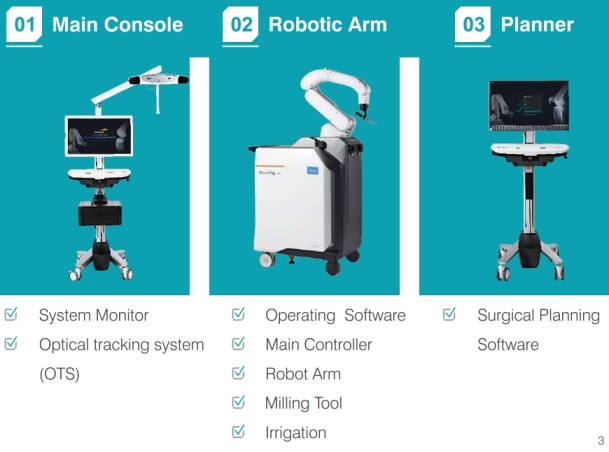The knee is a tough joint. A well-functioning network of bones, ligaments, cartilage, muscles, and nerves supports your knee while you’re moving, crouching, or even just standing still. You can require knee replacement surgery if any part of your knee is damaged, has arthritis, or is affected by another condition.
In these processes, precision is essential. The more precise a surgeon’s measuring equipment, the better they can prepare for and carry out your surgery.
What is Robotic Knee Replacement Surgery?
Robotic Knee Replacement is an advanced surgical procedure that uses robotic technology to assist a surgeon in performing a knee replacement surgery. This procedure is also known as Robotic Assisted Knee Replacement or Robotic Arm Assisted Knee Replacement.
During a Robotic Knee Replacement surgery, the surgeon uses a computer program to create a virtual 3D model of the patient’s knee joint. This model is then used to guide the robotic arm in performing the surgery. The robotic arm is equipped with a camera and instruments that allow the surgeon to make very precise cuts and movements, ensuring accurate placement of the new knee joint components.
Robotic Knee Replacement surgery offers several advantages over traditional knee replacement surgery. One of the primary benefits is improved accuracy and precision, which can result in a better fit and alignment of the new knee joint components. This can lead to improved function and longevity of the joint, reducing the risk of complications and the need for revision surgery in the future.
Robotic Knee Replacement surgery is not suitable for everyone, and a surgeon will evaluate a patient’s individual case to determine if they are a good candidate for this type of surgery. Patients who are overweight or have a significant deformity of the knee joint may not be eligible for this procedure.
Dr Saurabh Giri is an experienced orthopedic surgeon who offers Robotic Knee Replacement as a treatment option for patients with knee pain. He has extensive training and experience in performing this procedure and utilizes the latest techniques and equipment to provide the best possible care to his patients.
Standard robotic knee replacement with CUVIS Joint typically comprises of :
- In-clinic Diagnosis
- Pre-surgery Planning (Virtual Simulation)
- Discharge from Hospital
- CT-Scan
- Autonomous Robotic Surgical Procedure
CUVIS Joint robot for knee replacement is based on 4 core values of simplicity, accuracy, flexibility and safety.
Simplicity
- 3D bone model generation with fast and easy CT image data
- Reduced surgery preparation time with convenient user interface
Accuracy
- Precise pre-surgical planning executed every time
- Sub-millimeter dimensional accuracy
Flexibility
- Various cutting options
- Provision for intra-operative plan changing and gap balancing
Safety
- Real time system monitoring
- Emergency stop and force freeze with an option of manual guide of robot arm.
What are the Advantages of Robotic Knee Replacement Surgery?
Robotic Knee Replacement Surgery offers several advantages over traditional knee replacement surgery, including:
- Improved Accuracy and Precision: One of the most significant benefits of Robotic Knee Replacement Surgery is the improved accuracy and precision of the procedure. Robotic technology allows for the creation of a detailed 3D model of the patient’s knee joint, which is used to guide the surgeon in performing the surgery. The robotic arm is capable of making very precise cuts and movements, ensuring accurate placement of the new knee joint components. This can lead to a better fit and alignment of the components, resulting in improved function and longevity of the joint.
- Minimally Invasive: Robotic Knee Replacement Surgery is a minimally invasive procedure, meaning that the incision is smaller, and there is less damage to the surrounding tissue. This can lead to less pain, scarring, and a shorter recovery time for the patient.
- Reduced Blood Loss: Robotic Knee Replacement Surgery typically results in less blood loss than traditional knee replacement surgery. This is because the robotic arm uses a highly precise cutting tool, which minimizes damage to surrounding tissues.
- Faster Recovery: Due to the minimally invasive nature of the procedure, patients who undergo Robotic Knee Replacement Surgery typically experience a faster recovery time than those who undergo traditional knee replacement surgery.
In summary, Robotic Knee Replacement Surgery offers several advantages over traditional knee replacement surgery, including improved accuracy and precision, a minimally invasive approach, reduced blood loss, faster recovery, personalized treatment, and a lower risk of complications. If you are considering knee replacement surgery, talk to your doctor about whether Robotic Knee Replacement Surgery is right for you.
WHY ROBOTIC JOINT SURGERY?
Knee Replacement Procedures: Traditional VS Robotic
Knee replacement surgery is a common procedure that has been performed for several decades, and while traditional knee replacement surgery is widely available and has a lower cost, it also has its limitations. In recent years, robotic knee replacement surgery has emerged as a newer approach that utilizes advanced technology to enhance precision and reduce the risk of complications.
Traditional knee replacement surgery involves making an incision in the knee and removing the damaged cartilage and bone before replacing them with metal or plastic components. This process typically takes less time to perform, is less expensive, and is widely available. However, the traditional approach is heavily reliant on the surgeon’s skill and experience to properly align the implant components, which can lead to imprecise placement. Additionally, traditional knee replacement surgery has a higher risk of complications, such as infection, blood loss, and blood clots. Furthermore, the recovery process can take several weeks or months, which can cause more discomfort for the patient.

Robotic Knee Replacement Surgery

Traditional Knee Replacement Surgery
Robotic knee replacement surgery is a newer approach that utilizes advanced technology to help the surgeon perform the procedure with greater precision. The surgeon uses a robotic arm to remove the damaged cartilage and bone and precisely place the implant components. The robotic arm allows for greater precision in the placement of the implant components, which can lead to better outcomes and fewer complications. Patients who undergo robotic knee replacement surgery may experience a faster recovery time compared to traditional knee replacement surgery.
While robotic knee replacement surgery is still relatively new, the use of this advanced technology has many benefits. It allows for a higher level of accuracy in the positioning and placement of implant components. This means that the patient is more likely to experience a successful outcome and a reduced risk of complications. Additionally, the recovery time for patients who undergo robotic knee replacement surgery is typically shorter compared to traditional knee replacement surgery.
However, robotic knee replacement surgery is not yet widely available and is typically more expensive than traditional knee replacement surgery. As with any surgical procedure, it is important to weigh the benefits and risks of each approach before making a decision. Patients should discuss their options with their surgeon to determine which approach is best for their individual needs.
AFTER SURGERY
You will be assisted to sit up about an hour after surgery. You will be encouraged to walk 3-4 hours after surgery. You will be assisted to stand and start walking with walker on same day of surgery. This is all possible with use of true balance technique and local infiltration of anaesthetic agent at time of surgery.
DAY 2 :
On day two you will be demonstrated exercises which includes knee cap tightening and loosening, ankle and toe movements. Knee range of movements will be started. You must do these exercises 15-20 times every hour. This will help to mobilise your knee.
DAY 3 & 4 :
Knee bending exercises will be increased. During the day you will be walking 3-4 times with walker. Once you gain confidence you will be demonstrated how to walk up a staircase. You will be allowed to do the exercise by yourself. You will be allowed to sit on chair.
IMPORTANT ADVICE :
You must not keep pillow or towel under the operated knee, this is to prevent flexion deformity of knee. To prevent knee deformity put one or two pillows under the lower 1/3rd of leg so that knee hangs in mid air and there is no pressure over heel area.
Robotic Knee Replacement Surgery at Dr Saurabh Giri, Helios Orthojoint, Pune
Robotic Knee Replacement Surgery is a state-of-the-art surgical technique that uses robotic technology to assist surgeons during knee replacement procedures. At Dr Saurabh Giri Helios Orthojoint, this advanced technology is used to perform knee replacement surgeries with a high level of accuracy and precision.
Dr Saurabh Giri is a highly skilled and experienced orthopedic surgeon who specializes in knee replacement surgeries. He has performed numerous knee replacement surgeries using both traditional and robotic techniques. With the use of robotic technology, Dr. Giri is able to create a customized surgical plan for each patient, based on their unique anatomy and alignment.
If you are experiencing knee pain or have been diagnosed with a knee condition that may require surgery, contact Dr Saurabh Giri Helios Orthojoint to schedule a consultation. With the use of robotic technology and a personalized approach to care, Dr Giri can help you get back to the activities you love with less pain and greater function.




